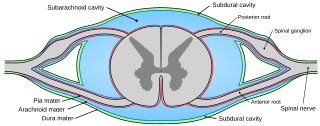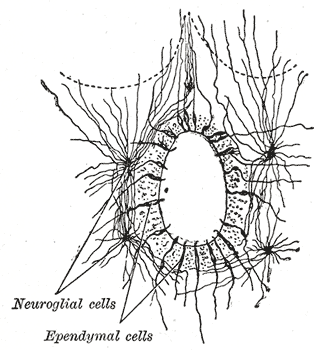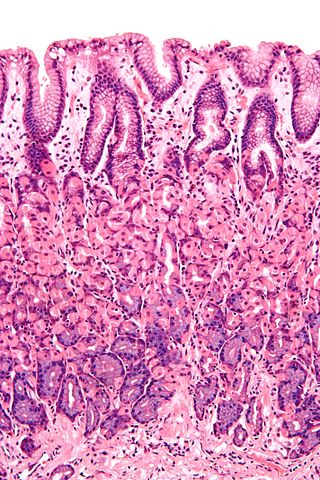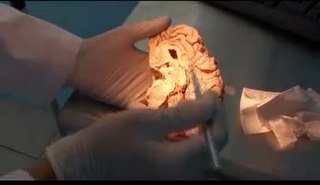Related Research Articles

Cerebrospinal fluid (CSF) is a clear, colorless body fluid found within the tissue that surrounds the brain and spinal cord of all vertebrates.

Hydrocephalus is a condition in which an accumulation of cerebrospinal fluid (CSF) occurs within the brain. This typically causes increased pressure inside the skull. Older people may have headaches, double vision, poor balance, urinary incontinence, personality changes, or mental impairment. In babies, it may be seen as a rapid increase in head size. Other symptoms may include vomiting, sleepiness, seizures, and downward pointing of the eyes.

The ventricular system is a set of four interconnected cavities known as cerebral ventricles in the brain. Within each ventricle is a region of choroid plexus which produces the circulating cerebrospinal fluid (CSF). The ventricular system is continuous with the central canal of the spinal cord from the fourth ventricle, allowing for the flow of CSF to circulate.

Lumbar puncture (LP), also known as a spinal tap, is a medical procedure in which a needle is inserted into the spinal canal, most commonly to collect cerebrospinal fluid (CSF) for diagnostic testing. The main reason for a lumbar puncture is to help diagnose diseases of the central nervous system, including the brain and spine. Examples of these conditions include meningitis and subarachnoid hemorrhage. It may also be used therapeutically in some conditions. Increased intracranial pressure is a contraindication, due to risk of brain matter being compressed and pushed toward the spine. Sometimes, lumbar puncture cannot be performed safely. It is regarded as a safe procedure, but post-dural-puncture headache is a common side effect if a small atraumatic needle is not used.

Pia mater, often referred to as simply the pia, is the delicate innermost layer of the meninges, the membranes surrounding the brain and spinal cord. Pia mater is medieval Latin meaning "tender mother". The other two meningeal membranes are the dura mater and the arachnoid mater. Both the pia and arachnoid mater are derivatives of the neural crest while the dura is derived from embryonic mesoderm. The pia mater is a thin fibrous tissue that is permeable to water and small solutes. The pia mater allows blood vessels to pass through and nourish the brain. The perivascular space between blood vessels and pia mater is proposed to be part of a pseudolymphatic system for the brain. When the pia mater becomes irritated and inflamed the result is meningitis.

The choroid plexus, or plica choroidea, is a plexus of cells that arises from the tela choroidea in each of the ventricles of the brain. Regions of the choroid plexus produce and secrete most of the cerebrospinal fluid (CSF) of the central nervous system. The choroid plexus consists of modified ependymal cells surrounding a core of capillaries and loose connective tissue. Multiple cilia on the ependymal cells move to circulate the cerebrospinal fluid.

The fourth ventricle is one of the four connected fluid-filled cavities within the human brain. These cavities, known collectively as the ventricular system, consist of the left and right lateral ventricles, the third ventricle, and the fourth ventricle. The fourth ventricle extends from the cerebral aqueduct to the obex, and is filled with cerebrospinal fluid (CSF).

The ependyma is the thin neuroepithelial lining of the ventricular system of the brain and the central canal of the spinal cord. The ependyma is one of the four types of neuroglia in the central nervous system (CNS). It is involved in the production of cerebrospinal fluid (CSF), and is shown to serve as a reservoir for neuroregeneration.

The subfornical organ (SFO) is one of the circumventricular organs of the brain. Its name comes from its location on the ventral surface of the fornix near the interventricular foramina, which interconnect the lateral ventricles and the third ventricle. Like all circumventricular organs, the subfornical organ is well-vascularized, and like all circumventricular organs except the subcommissural organ, some SFO capillaries have fenestrations, which increase capillary permeability. The SFO is considered a sensory circumventricular organ because it is responsive to a wide variety of hormones and neurotransmitters, as opposed to secretory circumventricular organs, which are specialized in the release of certain substances.

The arachnoid mater is one of the three meninges, the protective membranes that cover the brain and spinal cord. It is so named because of its resemblance to a spider web. The arachnoid mater is a derivative of the neural crest mesoectoderm in the embryo.

Simple columnar epithelium is a single layer of columnar epithelial cells which are tall and slender with oval-shaped nuclei located in the basal region, attached to the basement membrane. In humans, simple columnar epithelium lines most organs of the digestive tract including the stomach, and intestines. Simple columnar epithelium also lines the uterus.

The central canal is the cerebrospinal fluid-filled space that runs through the spinal cord. The central canal lies below and is connected to the ventricular system of the brain, from which it receives cerebrospinal fluid, and shares the same ependymal lining. The central canal helps to transport nutrients to the spinal cord as well as protect it by cushioning the impact of a force when the spine is affected.

The obex is the point in the human brain at which the fourth ventricle narrows to become the central canal of the spinal cord. Cerebrospinal fluid can flow from the fourth ventricle into the obex. In anatomical studies, the obex has been found to occur approximately 10-12 mm above the level of the foramen magnum. In patients with low tonsillar position, the obex has been found below the plane of the foramen magnum.

Circumventricular organs (CVOs) are structures in the brain characterized by their extensive and highly permeable capillaries, unlike those in the rest of the brain where there exists a blood–brain barrier (BBB) at the capillary level. Although the term "circumventricular organs" was originally proposed in 1958 by Austrian anatomist Helmut O. Hofer concerning structures around the brain ventricular system, the penetration of blood-borne dyes into small specific CVO regions was discovered in the early 20th century. The permeable CVOs enabling rapid neurohumoral exchange include the subfornical organ (SFO), the area postrema (AP), the vascular organ of lamina terminalis, the median eminence, the pituitary neural lobe, and the pineal gland.

The subcommissural organ (SCO) is one of the circumventricular organs of the brain. It is a small glandular structure that is located in the posterior region of the third ventricle, near the entrance of the cerebral aqueduct.

Tanycytes are special ependymal cells found in the third ventricle of the brain, and on the floor of the fourth ventricle and have processes extending deep into the hypothalamus. It is possible that their function is to transfer chemical signals from the cerebrospinal fluid to the central nervous system.

Ernst Reissner was a Baltic German anatomist from Riga, Livonia.

SCO-spondin is a protein that in humans is encoded by the SSPO gene. SCO-spondin is secreted by the subcommissural organ, and contributes to commissural axon growth and the formation of Reissner's fiber, a fibrous aggregation of secreted molecules extending from the subcommissural organ to the end of the spinal cord.

An external ventricular drain (EVD), also known as a ventriculostomy or extraventricular drain, is a device used in neurosurgery to treat hydrocephalus and relieve elevated intracranial pressure when the normal flow of cerebrospinal fluid (CSF) inside the brain is obstructed. An EVD is a flexible plastic catheter placed by a neurosurgeon or neurointensivist and managed by intensive care unit (ICU) physicians and nurses. The purpose of external ventricular drainage is to divert fluid from the ventricles of the brain and allow for monitoring of intracranial pressure. An EVD must be placed in a center with full neurosurgical capabilities, because immediate neurosurgical intervention can be needed if a complication of EVD placement, such as bleeding, is encountered.

The spinal cord is a long, thin, tubular structure made up of nervous tissue that extends from the medulla oblongata in the brainstem to the lumbar region of the vertebral column (backbone) of vertebrate animals. The center of the spinal cord is hollow and contains a structure called central canal, which contains cerebrospinal fluid. The spinal cord is also covered by meninges and enclosed by the neural arches. Together, the brain and spinal cord make up the central nervous system (CNS).
References
- ↑ Butler, Ann; William Hodos (Aug 23, 2005). Comparative Vertebrate Neuroanatomy: Evolution and Adaptation. John Wiley & Sons. p. 715. ISBN 978-0471888895.
- 1 2 Gobron, S.; Creveaux, I.; Meiniel, R.; Didier, R.; Dastugue, B.; Meiniel, A. (1999). "SCO-spondin is evolutionarily conserved in the central nervous system of the chordate phylum". Neuroscience. 88 (2): 655–664. doi:10.1016/s0306-4522(98)00252-8. PMID 10197783. S2CID 426154.
- ↑ Vigh, B. L.; Vigh-Teichmann, I. (1998). "Actual problems of the cerebrospinal fluid-contacting neurons". Microscopy Research and Technique. 41 (1): 57–83. doi: 10.1002/(SICI)1097-0029(19980401)41:1<57::AID-JEMT6>3.0.CO;2-R . PMID 9550137.
- ↑ Hofer H, Meinel W, Erhardt H (1980). "Electron microscopic study of the origin and formation of Reissner's fiber in the subcommissural organ of Cebus apella (Primates, Platyrrhini)". Cell and Tissue Research. 205 (2): 295–301. doi:10.1007/bf00234687. PMID 6766807. S2CID 25277195.
- ↑ Castañeyra-Perdomo A, Meyer G, Ferres-Torres R (1983). "Development of the subcommissural organ in the albino mouse (a Golgi study)". Journal für Hirnforschung. 24 (4): 363–70. PMID 6643990.
- 1 2 3 4 Oksche A, Rodríguez EM, Llebrez PF (1993). Oksche A, Rodríguez EM, Fernández-Llebrez P (eds.). The Subcommissural Organ: An Ependymal Brain Gland. Berlin: Springer Verlag. doi:10.1007/978-3-642-78013-4. ISBN 978-3-540-56336-5. OCLC 27681500. S2CID 36028700.[ page needed ]
- ↑ Rodríguez EM, Oksche A, Montecinos H (March 2001). "Human subcommissural organ, with particular emphasis on its secretory activity during the fetal life". Microscopy Research and Technique. 52 (5): 573–90. doi:10.1002/1097-0029(20010301)52:5<573::AID-JEMT1042>3.0.CO;2-6. hdl: 10533/172756 . PMID 11241867. S2CID 22572195.
- 1 2 3 Chatoui H, El Hiba O, Elgot A, Gamrani H (April 2012). "The rat SCO responsiveness to prolonged water deprivation: implication of Reissner's fiber and serotonin system". Comptes Rendus Biologies. 335 (4): 253–60. doi:10.1016/j.crvi.2012.03.011. PMID 22578571.
- 1 2 3 4 Meiniel R, Meiniel A (1985). "Analysis of the secretions of the subcommissural organs of several vertebrate species by use of fluorescent lectins". Cell and Tissue Research. 239 (2): 359–64. doi:10.1007/bf00218016. PMID 3919951. S2CID 11103968.
- 1 2 Pérez-Fígares JM, Jimenez AJ, Rodríguez EM (March 2001). "Subcommissural organ, cerebrospinal fluid circulation, and hydrocephalus". Microscopy Research and Technique. 52 (5): 591–607. doi:10.1002/1097-0029(20010301)52:5<591::AID-JEMT1043>3.0.CO;2-7. hdl: 10533/172867 . PMID 11241868. S2CID 43438412.
- ↑ Elgot A, Ahboucha S, Bouyatas MM, Fèvre-Montange M, Gamrani H (November 2009). "Water deprivation affects serotoninergic system and glycoprotein secretion in the sub-commissural organ of a desert rodent Meriones shawi". Neuroscience Letters. 466 (1): 6–10. doi:10.1016/j.neulet.2009.08.058. PMID 19716402. S2CID 20941735.
- ↑ Caprile T, Hein S, Rodríguez S, Montecinos H, Rodríguez E (February 2003). "Reissner fiber binds and transports away monoamines present in the cerebrospinal fluid". Brain Research. Molecular Brain Research. 110 (2): 177–92. doi:10.1016/S0169-328X(02)00565-X. PMID 12591155.
- ↑ Hoyo-Becerra C, López-Avalos MD, Pérez J, et al. (December 2006). "Continuous delivery of a monoclonal antibody against Reissner's fiber into CSF reveals CSF-soluble material immunorelated to the subcommissural organ in early chick embryos". Cell and Tissue Research. 326 (3): 771–86. doi:10.1007/s00441-006-0231-3. PMID 16788834. S2CID 24691620.